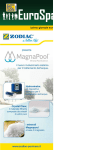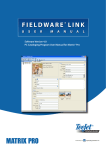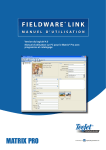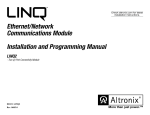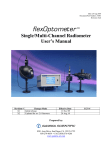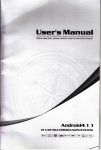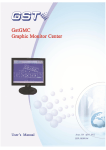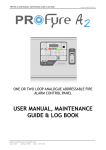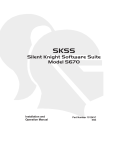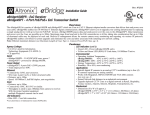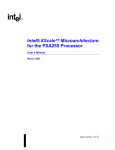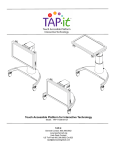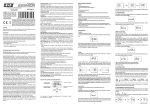Download Installation Instructions
Transcript
Network Power Distribution Module Installation and Programming Manual LINQ8PD - Network Power Distribution Module - Eight (8) Fused Outputs LINQ8PDCB - Network Power Distribution Module - Eight (8) PTC Outputs DOC#: LINQ8PD Rev. 110515 More than just power.™ Overview: Altronix LINQ8PD(CB) network power distribution module facilitates monitoring, reporting and control of one (1) or two (2) low voltage AC or supervised DC power supply/chargers over the network. Reports diagnostics via Email/SNMP notifications greatly reducing system downtime and eliminating unnecessary service calls. LINQ8PD(CB) retrofits with most currently installed multi-output power supply/chargers. Specifications: Input Power: Network Security: Programming Features: • Input1/Input2: 12VAC-28VAC @ 12.5 amp each or 12VDC/28VDC @ 12.5 amp each Note: Do connect AC and DC simultaneously to INP1 and INP2 • Secure Socket Layer (SSL) • Power Supply(ies) voltage and load limits (High/Low) • FACP trigger type (wet or dry-N.O./N.C.) • Input Function (FACP reset/tamper) • Output Reset Trigger (N.O./N.C.) • Battery Monitor Configuration: - Capacity - Charge Level - Max. Charge and Discharge Current - Service Date • Configurable Output Relay(s) • Individual Output Configuration: - Device ID - Voltage and Current Limits (High/Low) - FACP Trigger Setting (latching/non-latching/inactive) - Battery Backup Outputs: • Eight (8) fused or PTC protected outputs: -LINQ8PD: Blade fuses are rated 3 amps -LINQ8PDCB: PTCs are rated 2.5 amps • Power output(s) can be locally or remotely controlled • Surge Suppression Status Monitoring: • Power Supply(ies) output voltage and load • Voltage and load of each output • FACP trigger and reset status • Unit temperature (Celsius) • Power Supply AC and Battery status • Battery health Reporting: • SNMP trap messages. • E-mail notifications • Event Log tracks history Fire Alarm Interface: • Supervised FACP disconnect (Latching or Non-Latching) • FACP reset (N.C. or N.O.) Mechanical: • Board Dimensions: 5.5”L x 3.625”W x 0.96”H (139.7mm x 92.07mm x 24.38mm) • Product weight (approx.): 0.4 lbs. (0.18kg) • Shipping weight (approx.): 0.7 lbs. (0.32kg) Terminal/Connector Identification: LINQ8PD - Fig. 1 A B C D E F G BAT LOCAL FACP IN -- FACP RLY 2 GND GND RET -RESET FACP EOL RET+ FACP IN+ FACP RLY 1 H LINQ8PD AC 3 FUSE OUT8 3 FUSE OUT7 FUSE OUT6 3 K NO BAT C L NO AC C ---- OUT1 + -- OUT2 + -- OUT3 + -- OUT4 + -- OUT5 + O - 2 - 3 FUSE OUT5 3 FUSE OUT4 3 FUSE OUT3 3 FUSE OUT2 FUSE OUT1 Fuse Battery 3 I J DRY Inputs P + BAT OUT - Q 15 FACP + BAT IN - R 15 Altronix Corp. Brooklyn, NY 11220 BAT -- INP2 + ~ ~ S UPLINK DOWNLINK -- INP1 + ~ ~ T <INP1 OFF INP2> U 15 -- OUT6 + -- OUT7 + -- OUT8 + AC Fail NC C N NC C Battery Fail M LINQ8PD/LINQ8PDCB A B C D E F G H I Terminal/Connector Identification: A B C D E F G H I J A B C D E F G H I J K J K L K L M L M N M N O P Q R N O P Q R S O P Q R S T Terminal/Legend A GND, B C RESET D E F G H B C D FACP E F EOL G H I GND, C D E F + RET -- G H I J D FACP E F --GINH+ I J K E FACP F G RLY H I 1, J2 K L F Downlink G H I J K L M G H I J K L M N Uplink H BAT I J Local K LLED M N O I FACP/AC/BAT J K L M N LEDs O P J K L M N O Heartbeat LED P Q K RJ45 L M N O P Q R L M N O P Q R S USB Battery Fail M N O P Q R S T NC, C, NO AC Fail N O P Q R S T U NC, C, NO + OUT1 -- to O P Q R S T U + OUT8 -P Q S C T U ACR/ NO, Q R S/T BAT NO,UC R + S BAT T UOUT -S + T BAT U IN --- INP2 + T U U -- INP1 + Description I J reset. K L M N O P Q R S T U FACP J K L to M EOL N O P QLINQ8PD(CB). R S T U Connects or next Q R S T U K L EOL, M N orOnext P LINQ8PD(CB). FACP Q R +.S T U L Minput N from O P FACP Wet M N reporting O P Q relay. R S T U FACP N O P Q toRpower S Tsupply U or second LINQ8PD(CB) module. Connection O P Q to R next S TLINQ8PD(CB) U Connects upstream from this module. If this is the first LINQ8PD(CB) in the daisy chain this connector is not used. Q R battery(ies) P S T U thresholds. Indicates Q R S status T U of FACP, AC and Battery. Indicates R S T U Indicates the LINQ8PD(CB) is operational. SEthernet: T U LAN or laptop connection enables LINQ8PD(CB) programming and status monitoring. T U connection enables LINQ8PD(CB) initial setup and programming. Laptop Indicates low battery condition, e.g. connect to alarm panel. Relay normally energized when DC power is present. U Contact rating 1 amp @ 30VDC. Indicates loss of AC power, e.g. connect to audible device or alarm panel. Relay normally energized when AC power is present. Contact rating 1 amp @ 30VDC (power-limited). 24VAC/28VAC or 12VDC/24VDC continuous output. Connection to [AC Fail] terminals on power supply. Connection to [BAT Fail] terminals on power supply. Connection to stand-by batteries. Connection to [+ BAT -- ] terminals on power supply. Second AC or DC power supply input. Note: Do connect AC and DC simultaneously to INP1 and INP2. First AC or DC power supply input. Note: Do connect AC and DC simultaneously to INP1 and INP2. LED Diagnostics: LED BAT LOCAL FACP AC BAT OUT1-OUT8 LINQ8PD/LINQ8PDCB Flash Codes ON Blinking ON OFF ON OFF ON OFF ON OFF Blinking Description Charge/Discharge current working properly Charge/Discharge current on the battery exceed limits FACP triggered FACP released Input signal active Input signal inactive Input signal active Input signal inactive Output is ON and working properly Output is OFF Output is ON and voltage and/or current exceeds limits -3- Installation Instructions: Wiring methods shall be in accordance with the National Electrical Code/NFPA 70/NFPA 72/ANSI, and with all local codes and authorities having jurisdiction. Product is intended for indoor use only and should be installed by qualified personnel. 1. Disconnect the AC mains and batteries (if used) from the power supply(ies) before connecting the LINQ8PD(CB) 2. Mount LINQ8PD(CB) into position and secure with mounting screws. Interconnecting two (2) LINQ8PD(CB) modules: Two (2) LINQ8PD(CB)s can be interconnected to enable both units to be accessed from a single IP address. Connect interface cable (supplied) to the interface port marked [DOWNLINK] of first LINQ8PD(CB) which will be the master to interface port marked [UPLINK] of second LINQ8PD(CB). 3. Power Supply Input Connection: The LINQ8PD(CB) can be connected to two independent AC or DC power supplies that can be routed thru each of the individual outputs. Each output is equipped with an input selection switch which is used to route the desired input to the output. This switch also has a center off position that can be used to turn power off to an output. (a)Single Power Supply Input: Connect the output of the power supply to the terminals marked [+INP1-] and set the Input selection switch for each output to the [INP1] position. (b)Dual Power Supply Inputs: When the use of two independent power supplies is desired connect one power supply to the terminals marked [+INP1-] and the second power supply to the terminals marked [+INP2-]. Set the Input selection switch for each output to the appropriate position. Reconnect the AC mains of the connected power supply(ies) and verify the voltage of each of the eight outputs. This helps avoid potential damage. Disconnect the AC mains of the connected power supply(ies). Note: Do connect AC and DC simultaneously to INP1 and INP2. 4. Output Connections: Connect devices to be powered to the terminals marked [-OUT1+ to -OUT8+] on LINQ8PD(CB) carefully observing polarity. When two power supplies are connected to the LINQ8PD(CB) verify that the output voltage matches the operating voltage of the connected devices. 5. Battery Connections: Skip this step when connecting AC power supplies or DC power supply(ies) without batteries. Connect the power supplies battery charging circuit to the terminals marked [+BAT IN-], connect the battery leads to the terminals marked [+BAT OUT-]. Note: Do not connect battery(ies) until all connections have been made. For 24VDC operation connect two 12VDC batteries in series using the supplied yellow battery jumper. For Access Control applications batteries are optional. When batteries are not used, a loss of AC will result in the loss of output voltage. When the use of stand-by batteries is desired, they must be lead acid or gel type. 6. Battery and AC Supervision Connections: Skip this step when connecting AC power supplies These connections are required to monitor AC and Battery Trouble conditions. These conditions cannot be monitored when connected to a non-supervised power supply. Connect the common (C) and normally open (N.O.) contact of the power supplies AC and Battery supervision relay to the corresponding DRY Inputs of the LINQ8PD(CB). If required to connect supervisory trouble reporting devices to outputs marked [AC FAIL, BAT FAIL] supervisory relay outputs marked [NC and C] to appropriate notification devices. Use 22 AWG to 18 AWG for supervision reporting. 7. Fire Alarm Interface options: (not evaluated by UL) The Fire Alarm Interface and Reset options are programmable via the web interface. FAI input trigger options: supervised normally closed [NC], normally open [NO], polarity reversal input from signaling circuit or wet input will trigger selected outputs. (a)Normally Open [NO] input: Connect the supplied 2.2k resistor (supplied) in parallel with the normally open trigger circuit to the terminals marked [GND, FACP EOL]. (b)Normally Closed [NC] input: Connect the supplied 2.2k resistor (supplied) in series with the normally closed trigger circuit to the terminals marked [GND, FACP EOL]. (c) Signaling Circuit/Wet input trigger: Connect the positive (+) and negative (-) of the signaling circuit/wet input trigger to the terminals marked [FACP IN + and [FACP IN -]. (d)Fire Alarm Reset: If a output is programmed to latch with manual reset connect either a normally open (N.O.) or normally closed (N.C.) dry input to the terminals marked [RESET & GND] 8. Reconnect AC power mains to the connected power supply(ies) and connect back-up batteries. - 4 - LINQ8PD/LINQ8PDCB Establishing Network Connection: Network Setup - Altronix Dashboard USB Connection The USB connection on the LINQ8PD(CB) is used for Network and Trap Receiver configuration only. When connected to a PC via the USB cable the LINQ8PD(CB) will receive power from the USB port allowing programming of the LINQ8PD(CB) prior to being connected to the power supply. 1. Install the software supplied with the LINQ8PD(CB) on the PC being used for programming. This software should be installed on all computers that will have access to the LINQ8PD(CB). 2. Connect the supplied USB cable to the USB port on the LINQ8PD(CB) and the computer. 3. Click [Dashboard Icon] on the desktop of the computer and open the Dashboard. 4. Click [USB Network Setup] button located in the upper right hand side of the Dashboard. This will open the USB Network Setup screen. In this screen the MAC Address of the LINQ8PD(CB) module will be found along with the Network Settings, Trap Receiver Settings and SNMP Port Settings. 1. Network Settings (Fig. 2a, pg. 5): In the IP Address Method field select the method that the IP Address for the LINQ8PD will be obtained “Static” or “DHCP” then follow the appropriate steps. STATIC: Field Name Description Enter the IP address assigned to the LINQ8PD(CB) by the IP Address network administrator. Subnet Mask Enter the Subnet of the network. Enter the TCP/IP gateway of the network access point (router) being used Gateway Note: Gateway configuration is required to properly receive emails from the device. Enables standard remote access and monitoring. Enter the port HTTP Port number assigned to the LINQ8PD(CB) module by the network administrator. Default Port setting 80.* Enables secure remote access and monitoring. Enter the port numHTTPS Port ber assigned to the LINQ8PD(CB) module by the network administrator. Default Port setting 443.* Used to update device firmware. Enter the port number System Port assigned to the LINQ8PD(CB) module by the network administrator. Default Port setting 667* a. Click [Submit Network Settings] button, a dialog box will display “New network settings will take effect after the server is rebooted” click “OK”. *Note: When remote access is required or using multiple devices on the same network it is recommended to assign an independent port to each connected device. Fig. 2 x Dashboard - USB Network Setup Linq8 USB Network Settings MAC Address BC:34:00:30:01:77 A Network Settings: IP Address Method: IP Address: Subnet Mask: Gateway: HTTP Port: B Trap Receiver Settings: Trap Receiver 1 : STATIC 192.168.168.108 Trap Receiver 2 : 255.255.255.0 Trap Receiver 3 : 192.168.0.11 Trap Receiver 4 : 80 Trap Receiver 5 : HTTPS Port: 443 System Port: 667 Submit Trap Receiver IP Settings C SNMP Port Settings : Submit Network Settings SNMP Port : 161 Trap Messages Port : 162 Restore Factory Settings Submit Port Settings D Reboot Server DHCP (Fig. 2a, pg. 5): Connect LINQ8PD(CB) to the DHCP router to obtain IP address. a. After selecting DHCP in the IP Address Method field click [Submit Network Settings] button, a dialog box will display “New network settings will take effect after the server is rebooted” click “OK”. Next click [Reboot Server] button (Fig. 2d, pg. 5). After the LINQ8PD(CB) reboots the IP address assigned will appear in the IP Address field. It is recommended to have the assigned IP Address reserved on the router to ensure continued access to the LINQ8PD(CB) (see the network administrator). LINQ8PD/LINQ8PDCB -5- Field Name Description Subnet Mask When operating in DHCP the router will assign the subnet mask values. Gateway Enter the TCP/IP gateway of the network access point (router) being used. Enables standard remote access and monitoring. Enter the port number assigned to the LINQ8PD(CB) module by the network administrator. HTTP Port Default Port setting 80.* Enables secure remote access and monitoring. Enter the port number assigned to the LINQ8PD(CB) module by the network administrator. HTTPS Port Default Port setting 443.* Used to update device firmware. Enter the port number assigned to the LINQ8PD(CB) module by the network administrator. System Port Default Port setting 667* b. Click [Submit Network Settings] button, a dialog box will display “New network settings will take effect after the server is rebooted” click “OK”. *Note: When remote access is required or using multiple devices on the same network it is recommended to assign an independent port to each connected device. 2. Trap Receiver Settings (Fig. 2b, pg. 5): a. Enter up to five SNMP trap receiver IP addresses. When accessing the LINQ8PD(CB) remotely, check with the network administrator for proper configuration. b. Click [Submit Trap Receiver IP Settings] button, a dialog box will display “New Trap Receiver IP settings will take effect after the server is rebooted” click “OK”. 3. SNMP Port Settings (Fig. 2c, pg. 5): SNMP uses the default port 161 for general SNMP messages and port 162 for SNMP trap messages. In the event these ports need to be changed, enter the new port numbers assigned by the network administrator. a. Click [Submit Port Settings] button, a dialog box will display “New Port settings will take effect after the server is rebooted” click “OK”. b. After all information has been entered, Click [Reboot Server] button (Fig. 2d, pg. 5), a dialog box will display “Please allow up to 30 sec for the server to reboot”, click “OK”. c. After the LINQ8PD(CB) has been rebooted all programmed information will be saved. d. Disconnect the USB cable from the LINQ8PD(CB) module. If the LINQ8PD(CB) has not been connected to the power supply(ies) being monitored, (refer to Installing LINQ8PD Board on pg. 2). e. Connect one end of the network cable to the network jack on the LINQ8PD(CB) and the other to the network connection or the PC to be used for programming. Note: Email notification must be setup via the Browser, Ref to Email Settings in the Browser Setup section of this manual. Browser Setup When not using the Altronix Dashboard USB connection for the initial Network setup, the LINQ8PD(CB) needs to be connected to the power supply(ies) being monitored (refer to Installing LINQ8PD Board on page ??) prior to programming. Factory Default settings: • IP Address: 192.168.168.168 • User Name: admin • Password: admin 1. Set the static IP address for the laptop to be used for programming to the same network IP address as the LINQ8PD(CB) i.e. 192.168.168.200 (default address of the LINQ8PD(CB) is 192.168.168.168). 2. Connect one end of the network cable to the network jack on the LINQ8PD(CB) and the other to the network connection of the laptop. 3. Open a browser on the computer and enter “192.168.168.168” into the address bar. A dialog box Authentication Required will appear requesting both user name and password enter the default values here. 4. Click [Log In] button. The status page of the LINQ8PD(CB) will appear. This page displays the real time status and health of each power supply connected to the LINQ8PD(CB). - 6 - LINQ8PD/LINQ8PDCB 1. Network setup: Click [Network Settings] tab. This will open the Network Setting screen. In this screen the MAC Address of the LINQ8PD(CB) module will be found along with the programming fields for the Network Settings, Trap Receiver Settings, SNMP Port Settings and Email Settings. Fig. 3 Device Management Interface Status Network Settings (Fig. 3a, pg. 7): In the IP Address Method field select the method that the IP Address for the LINQ8PD(CB) will be obtained “Static” or “DHCP” then follow the appropriate steps. Setup Network Settings Events Log Help Monday, Sept. 21 2015 [2:30 pm] Site ID: LINQ8 Network Settings: IP Address Method: STATIC A IP Address: 192.168.168.107 STATIC (Fig. 3a, pg. 7): Field Name Description IP Address Enter the IP address assigned to the LINQ8PD(CB) by the network administrator. Subnet Mask Enter the Subnet of the network. Enter the TCP/IP gateway of the network access point (router) being used Gateway Note: Gateway configuration is required to properly receive emails from the device. Enter the HTTP port number assigned to the LINQ8PD(CB) module by the network administrator to allow remote access and monitoring. HTTP Port The default inbound port setting is 80. HTTP is not encrypted and unsecure. Even though HTTP can be used for remote access it is recommended primarily for use with LAN connections. Enter the HTTPS port number assigned to the LINQ8PD module by the network administrator to allow remote access and monitoring. HTTPS Port The default inbound port setting is 443. Being encrypted and more secure HTTPS is highly recommended for remote access. Used to update device firmware. Enter the port number assigned to the System Port LINQ8PD(CB) module by the network administrator. Default Port setting 667* a. Click [Submit Network Settings] button, a dialog box will display “New network settings will take effect after the server is rebooted” click “OK”. Security Settings Network Settings D From: event.report@linqinfo Subject: Subnet Mask: 255.255.255.0 Username: event.report Gateway: 192.168.0.11 Password: • • • • • • • • HTTP Port: 80 SMTP server IP: smtp.gmail.com HTTPS Port: 443 SMTP server Port: 587 System Port: 667 Outgoing Email Address 1: MAC Address: BC:34:00:30:01:72 Outgoing Email Address 2: Submit Network Settings Outgoing Email Address 3: B Trap Receiver Settings: Email Settings: Trap Receiver IP Address 1: 192.168.168.200 Outgoing Email Address 4: Outgoing Email Address 5: Submit Test Email Trap Receiver IP Address 2: Submit Email Settings Trap Receiver IP Address 3: Trap Receiver IP Address 4: Restore Factory Settings Trap Receiver IP Address 5: Submit Trap Receiver IP Settings SNMP Port Settings: SNMP Port: 161 E Reboot Server C Trap Message Port: 162 Submit Port Settings DHCP (Fig. 3a, pg. 7): After selecting DHCP in the IP Address Method field click [Submit Network Settings] button, a dialog box will display “New network settings will take effect after the server is rebooted” click “OK”. Next click [Reboot Server] button. After rebooting the LINQ8PD(CB) will be set in the DHCP mode. The IP address will be assigned by the router when the LINQ8PD(CB) is connected to the network. It is recommended to have the assigned IP Address reserved to ensure continued access (see the network administrator). Field Name Description Subnet Mask When operating in DHCP the router will assign the subnet mask values. Gateway TCP/IP gateway of the network access point (router) being used will be displayed. Enter the HTTP port number assigned to the LINQ8PD(CB) module by the network administrator to allow remote access and monitoring. The default inbound HTTP Port port setting is 80. HTTP is not encrypted and unsecure. Even though HTTP can be used for remote access it is recommended primarily for use with LAN connections. Enter the HTTPS port number assigned to the LINQ8PD(CB) module by the network administrator to allow remote access and monitoring. HTTPS Port The default inbound port setting is 443. Being encrypted and more secure HTTPS is highly recommended for remote access. Click the [Submit Network Settings] button, a dialog box will display “New network settings will take effect after the server is rebooted” click “OK”. LINQ8PD/LINQ8PDCB -7- Trap Receiver Settings (Fig. 3b, pg. 7): a. Enter up to five SNMP trap receiver IP addresses. When accessing the LINQ8PD(CB) remotely check with the network administrator for proper configuration. b. Click [Submit Trap Receiver IP Settings] button, a dialog box will display “New Trap Receiver IP settings will take effect after the server is rebooted” click “OK”. SNMP Port Settings (Fig. 3c, pg. 7): SNMP uses the default port 161 for general SNMP messages and port 162 for SNMP trap messages. In the event these port need to be changed enter the new port numbers assigned by the network administrator. Click [Submit Port Settings] button, a dialog box will display “New SMNP port settings will take effect after the server is rebooted” click “OK”. Email Settings (Fig. 3d, pg. 7): The LINQ8PD(CB) can send emails via an in-house email server, email service provider (i.e. Gmail, Yahoo) or Altronix default email service. In-house email server: Field Name Description From Enter the email address assigned to the LINQ8PD(CB) module by the system administrator. Subject Identify the location of the v (i.e. the Site ID). Username Enter the username associated with the LINQ8PD(CB) module email address. Password Enter the username password. SMTP server IP Enter the SMTP IP address of the in-house email server. SMTP server Port Enter the SMTP port assigned to the in-house email server. Outgoing Email Address 1-5 Enter up to five outgoing email addresses. a. Click [Submit Email Settings] button and the email settings will be saved. Email service provider: Field Name Description From Enter the email address for the LINQ8PD(CB) module. Subject Identify the location of the LINQ8PD(CB) (i.e. the Site ID). Username Enter the username associated with the LINQ8PD(CB) module email address. Password Enter the username password. SMTP server IP Enter the SMTP IP address of the email service provider. SMTP server Port Enter the email SMTP port number. The default SMTP email ports are 25 or 465 unless otherwise specified. Outgoing Email Address 1-5 Enter up to five outgoing email addresses. a. Click [Submit Email Settings] button and the email settings will be saved. Altronix default email service: a. All required sender and network fields have already been populated. b. Outgoing Email Address 1-5: Enter up to five outgoing email addresses. c. Click [Submit Email Settings] button to save the email settings. d. Test the email setup by clicking [Test Email] button. e. An email will be sent to all Outgoing email addresses. If the test email is not received contact the network administrator and repeat the email setup steps. f. After all fields have been programed, click [Reboot Server] button, a dialog box will display “Please allow up to 30 sec. for server to reboot” click “OK”. All programmed information will be saved after the server has rebooted. - 8 - LINQ8PD/LINQ8PDCB Device Management Interface 2.Setup (Fig. 4, pg. 9): Note: If the Altronix Dashboard is being used for LINQ8PD(CB) setup, refer to the Folder and Device configuration section in the Altronix Dashboard setup/user manual. Click on [Setup] tab. The LINQ8PD(CB) setup page will open. This page is used to configure all operating functions of the LINQ8PD(CB). Fig.Status 4 Setup A Site B C ID D E F G A A B A B C A B C D B C D E C D E F G Date/Time D E F G ID H LINQ8PD(CB) E F G H PS2 Presence I F G Presence H I J Battery H I J K A Site ID: Enter Location C Enter ID PS1 Volts High Limit Field Name Network Settings Setup 27.7 Security Settings Help Monday, Sept. 21 2015 [2:30 pm] Update Site ID PS2 Presence No Update Events Log V PS2 Volts High Limit 14 V D Battery Presence No FACP Trigger E 7 Bat Capacity Dry PS1/PS2 Amp Limit 3 0 27.7 3 Latching Yes On 2 Enter ID 3 0 27.7 3 Non-Latching No On 3 Enter ID 3 0 27.7 3 Inactive Yes On 4 Enter ID 3 0 27.7 3 Latching No On 5 Enter ID 3 0 27.7 3 Non-Latching Yes On 6 Enter ID 3 0 27.7 3 Inactive No On 7 Enter ID 3 0 27.7 3 Latching Yes On Off 8 Enter ID 3 0 27.7 3 Non-Latching No On Off Enter Fig. 5 ID Description Enter both the Voltage Limit High and Voltage Limit Low for the connected power supplies. If either of these limits are exceeded an SNMP trap message and/or email notification will be generated. Enter both the Amp Limit High and Amp Limit Low for the connected power supplies. If either of these limits are exceeded an SNMP trap message and/or email notification will be generated. Reset Tamper Status Setup Network Settings Description Normally Open reset Trigger Input. Normally Closed Trigger input. C Update 27.7 V PS2 Volts H PS1 Volts Low Limit 4 V PS2 Volts L PS1 Amps High Limit 3 PS1 Amps Low Limit Security Settings A C Enter ID PS1 Volts High Limit 27.7 Update Fig. PS2 Presence No A PS2 Amps 0 A PS2 Amps Events Log Output Setup Output Select N.O. N.C. A Device Management Interf Description PS1 Volts Low Limit 4 When using the FACP Interface with outputs set in latching mode the reset trigger input PS1 Amps High Limit 3 is designated as the FACP manual release. PS1 Amps Low Limit When the outputs are set in non-latching mode or the FACP interface is not being used 0 the reset trigger input. Output Reset Trigger (Fig. 6, pg. 9): From the pull down menu select either N.O. or N.C. Network Se PS1 Volts High Limit Description Update Site ID Site ID: Enter Location Input voltage from the fire alarm signal circuit will disconnect all outputs programmed for FACP disconnect. A short or open on the supervised FACP input will disconnect all outputs programmed for FACP disconnect. Input Function (Fig. 6, pg. 9): From the pull down menu select either Reset or Tamper. Select D 02 /02 / 2015 Enter ID FACP Trigger (Fig. 6, pg. 9): From the pull down menu select either Wet or Dry. Select Wet Trigger Dry Trigger AH Battery Service Date 1 Submit Settings PS1/PS2 Voltage Limit Minimize Others Reset 90 % Output Relay 1 PS1 Volts Low Limit 4 V PS2 Volts Low Limit 10.01 V Input Function Bat Charge Level Com Trouble Description Max Battery 2.75 A Output Relay 2 PS1 Amps High Limit 3 A PS2 Amps High Limit 5 A Output Reset Trigger N.C. Tamper Discharge Current Enter a descriptive name that will identify the location (building, company or campus) where the50 LINQ8PD(CB) 0.9 A Output Relay 3 C Max Charge Current installed. FACP H I J K L M N O P Q R S T U PS1 Amps Low Limit 0 A PS2 Amps Low Limit 0 A Max Temp The Site ID will appear in both the trap message andOutput email notifications. Status Setup Device ID Current High (A) Current Low (A) Voltage High (V) Voltage Low (V) FACP Trigger Battery Backup Output Status Off I Clicking J K L M N Date/Time O P Qwith R Computer], S T U will set the LINQ8PD(CB) to the time of the host computer. on [Sync Off Setup J Enter K La descriptive M N O name P Qand/or R location S T Uof the LINQ8PD(CB). Off Off Site ID: Enter Location Q Rselect K From L MtheNpullOdown P menu S T U No to disable PS2 if only one power supply is connected. Off Q menu Off L From M NtheOpullPdown R S select T UNo if batteries are not connected. If batteries are not connected skip this section. PS1/PS2 Amps/Voltage Limits (Fig. 5, pg. 9): Field Name B Sync with computer Minimize Help Device ID Curren 1 Enter ID 3 2 Enter ID 3 3 Enter ID 3 6 D 4 5 Enter ID Battery Presence No Enter ID E 3 3 V PS2 Volts High Limit 14 V FACP Trigger Enter ID Dry 6 Bat 3Capaci V PS2 Volts Low Limit 10.01 V Input Function Enter ID Reset 7 Bat 3Charge A PS2 Amps High Limit 5 A Output Reset Trigger Enter ID N.C. 8 Max Batter 3 Discharge A PS2 Amps Low Limit A Max Temp Device ID 0 Current High (A) Current Low (A) C Max Charg 50 Voltage High (V) Voltage Low (V) 1 Enter ID 3 0 27.7 3 2 Enter ID 3 0 27.7 3 3 Enter ID 3 0 27.7 3 4 Enter ID 3 0 27.7 3 5 Enter ID 3 0 27.7 3 6 Enter ID 3 0 27.7 3 27.7 3 8 Enter ID 3 0 27.7 3 Max Temp: The LINQ8PD(CB) will measure the ambient temperature of the enclosure it is mounted in. Entering a high temperature limit in Celsius, Enter ID 7 3 0 if this limit is exceeded an SNMP trap message and/or email notification will be generated. LINQ8PD/LINQ8PDCB -9Submit Settings Battery Monitor Configuration (Fig. 7, pg. 10): The LINQ8PD(CB) displays the real time battery health. Select Battery Capacity Battery Charge Level Max. Battery Discharge Current Description Enter the battery rating in amp hours. Enter the estimated percentage charge level of the Battery at the time of installation. Enter the high current limit to be drawn from the battery in the event of a power failure. If this limit is exceeded an SNMP trap message and/or email notification will be generated. Enter the maximum charge current of the connected power supply. If this limit is exceeded an SNMP trap message and/or Max. Charge Current email notification will be generated. Enter the date on which the installed batteries need to be serviced. An SNMP trap message and/or email notification will be generated on the entered date. Battery Service Date Note: Batteries should be inspected at least once a year. Even though the expected battery life is 5 years, it is recommended changing batteries in 4 years. Device Management Interface Device Management Interface Status Setup Network Settings Security Settings Events Log Help Output Relay configuration (Fig. 7, pg. 10): Setup Status Setupof the Network Settings Securityfor Settings Log Help Three (3) output relays LINQ8PD(CB) can be configured various uses. Events From the pull down menu select the desired setting for each relay. A Site ID: Enter Location Output Relay 1: Setup Setting Description Update Site ID is detected. Site AC ID: Enter LocationThe relay will energize when AC trouble Update Enter ID PS2 Presence No Com Trouble The relay will energize when on all trouble conditions. Output Relay 2: Battery Enter ID Tamper PS1 Volts High Limit A C PS1 Volts High Limit C 27.7 V PS2 Volts High Limit 14 V D D Battery Presence No FACP Trigger Volts Low Limit 4 V PS2 Volts Low Limit 10.01 V Input Function The PS1 relay will energize when Battery trouble No is detected. Update PS2 Presence Battery Presence No Amps High Limit 3 when Athe PS2 Amps High Limit 5 A Output Reset Trigger The PS1 relay will energize tamper input is triggered. 27.7 V PS2 Volts High Limit 14 V FACP Trigger Dry E Minimize AH Battery Service Date Minimize Others 02 /02 / 2015 Dry Bat Capacity 7 Reset Bat Charge Level 90 % Output Relay 1 Com Trouble N.C. Max Battery Discharge Current 2.75 A Output Relay 2 Tamper 02 /02 / 2015 FACP E 7 Bat Capacity AH Battery Service Date 3 Non-Latching 2 Enter ID 3 Enter ID 4 Current Enter ID 5 3Enter ID 0 3 027.7 27.7 3 3 Latching Enter ID 3Enter ID 6 2 7 Output Configuration (Fig. 8, pg. 10): Enter ID 3 3Enter ID 0 3 027.7 27.7 3 3 Non-Latching Inactive 0 3 027.7 27.7 3 3 Enter ID 3 0 27.7 3 PS1 Amps Low Limit Fig. 8 Output 1 0 Device ID Enter ID Enter ID 4Field Name DeviceEnter ID ID 5 CurrentEnter High/Low ID 6 Enter ID 7Voltage High/Low 8 Enter ID A PS2 Amps Low Limit 8 0 High (A) A Max Temp 50 3 0 27.7 Current Low (A) 3 0 Voltage High (V) 27.7 C Max Charge Current 0.9 0 27.7 3 No 3 Relay Inactive 3 Voltage Low 3(V) A Output FACP Trigger Latching Inactive Non-Latching Latching Non-Latching 27.7 Description 3 0 3 Latching Enter a descriptive name for the device connected to the output. 3 0 3Submit Settings Non-Latching 27.7 Enter both the high current limit and low current limit in the appropriate fields for the connected Device. 3 these limits are exceeded 0 3 27.7message and/or email If either of an SNMP trap notification will beInactive generated. Enter both limit in the appropriate fields for the connected Device. 3 the high voltage limit 0 and low voltage27.7 3 Latching If either of these limits are exceeded an SNMP trap message and/or email notification will be generated. 3 Sync with computer Fig. 7 Discharge Current 27.7 B Minimize Others A Output Relay 3 PS1 Amps Low Limit 0 A PS2 Amps Low Limit 0 A Max Temp 50 C Max Charge Current 0.9 Output Relay 3 Reset 90 % Output Relay 1 4 V PS2 Volts Low Limit 10.01 V Input Function Bat Charge Level FACP The relay the FACP input is triggered. Outputwill energize Device when ID Current High (A) Current Low (A) Voltage High (V) Voltage Low (V) FACP Trigger Battery Backup Max Battery willEnter energize is triggered. Output Reset Trigger N.C.27.7 2.75Latching A Output Relay PS1Tamper Amps High Limit 3 The relay A1 PS2 Amps Limit the 5 tamper A input Yes2 3 0 3 ID High when 0 Sync with computer Minimize Monday, Sept. 21 2015 [2:30 pm] PS1 Volts Low Limit 3 B Monday, Sept. 21 2015 [2:30 pm] Update Site ID Non-Latching Yes Battery Backup No Com Trouble Output Status Tamper On Off FACPOn Off On Off Output Off On Status Yes Yes OnOn Off Off No No OnOn Off Off Yes Yes OnOn Off Off No On Off On Off Yes On Off No On Off Yes On Off No On Off No Submit Settings - 10 -LINQ8PD/LINQ8PDCB FACP Trigger (Fig. 8, pg. 10): From the pull down menu select how the output will operate when the FACP input is triggered. FACP Trigger Setting Function/Description Inactive The selected output will not switch when the FACP input is triggered. Non Latching The selected output will switch when the FACP input is triggered and reset when the FACP trigger input is returns to a non-triggered state. The selected output will switch to a latched position when the FACP input is triggered. The selected output will remain latched until Latching the Output Reset is triggered. Battery Backup (Fig. 8, pg. 10): From the pull down menu select Yes if the output will remain ON in the event of a power failure. Select No if the output will turn OFF in the event of a power failure. Output Status (Fig. 8, pg. 10): Output Status indicates if the output is On (powered) or Off (not powered). The output can be turned on or off the clicking [On/Off] button. After all fields have been programmed, click on [Submit Setting] button, a dialog box will display, New Setting Submitted click “OK”. All programmed information in now saved. 3. Security Settings (Fig. 9, pg. 11): Click on [Security Settings] tab. The LINQ8PD(CB) security setting page will open. This section is used to enable/disable Secure Socket Layer (SSL) and to change Username and Password. SSL will encrypt all the communication Fig. 9 with a secure key. An SSL certificate could be self-signed Device Management Interface or obtained from a third party certification company. SSL Certificate Setting (Fig. 9a, pg. 11): Generating a self-signed SSL Certificate and Key. Field Name Description Two letter code representing the state State where the organization is located. Location The city where the organization is located. The legal name of the organization. Organization This should not be abbreviated, and should include suffixes such as Inc., Corp, or LLC. Unit Name Name of the device. Domain name or IP address of the server. This is Common Name typically assigned by the network administrator. Email Address An email address used to contact the organization. Status Setup Network Settings Security Settings Events Log Help Security Settings eFlow Monday, Sept. 21 2015 [2:30 pm] Site ID: LINQ8 A SSL Certificate Settings: State: SSL Status: Certificate Status: No Cert B Key Status: No Key Locality: SSL State: Organization: Unit Name: Off Turn SSL On Change Username and Password: Common Name: Username: Email Address: C Password: Submit SSL Settings Confirm Password: Save Username and Password After all fields have been completed click [Submit SSL Settings] button, a dialog box will appear “Please allow up to 30 sec for server to reboot” click “OK”. A self-signed SSL certificate will be generated with the information provided in the “SSL certificate settings” fields. The certificate will be valid for 500 days, and time stamped with the time settings present on the LINQ8PD(CB) module. The date and time must be synced with the host computer before generating an SSL certificate. Using a private SSL certificate and Key: Private SSL Certificates and Keys must be uploaded using the Altronix Dashboard. For additional information refer to the Altronix Dashboard setup/user manual section “Updating firmware / SSL certificate and Key”. LINQ8PD/LINQ8PDCB - 11 - SSL Status: Certificate Status (Fig. 9b, pg. 11): Message Certificate OK Bad Certificate No Certificate Key Status (Fig. 9b, pg. 11): Descriptions Valid SSL Certificate. Invalid SSL Certificate. A Valid SSL Certificate has not been loaded. Message Key OK Bad Key No Key Descriptions Valid SSL Key. Invalid SSL Key. A valid SSL Key has not been loaded. SSL State: The SSL of the LINQ8PD(CB) can be turned on and off by clicking [Turning SSL On/Turning SSL Off] button. Change Username and Password: Field Name Description Username Enter the new Username (up to 32 characters) required to access the LINQ8PD(CB). Password Enter the new Password (up to 32 alpha numeric characters) required to access the LINQ8PD(CB). Confirm Password Re-enter the new Password. Click [Save Username and Password] button, a dialog box with appear, “New settings have been applied” click “OK”. After saving, the new username and password will be active. 4. Event Log and Heartbeat Timer (Fig. 10, pg. 12): Click [Event Log] tab. The LINQ8PD(CB) event log will open. This screen will display the event log along with the heartbeat timer setup. Event Log: The event log will display the 50 most recent events. To update the Event Log click [Display/Refresh Log] button, the most recent events will be displayed. Fig. 10 Device Management Interface Status Setup Network Settings Security Settings Events Log Help Event Log Site ID: LINQ8 Display/Refresh Log v1.99.22 Monday, Sept. 21 2015 [2:30 pm] Last updated: Heartbeat Timer Settings Heartbeat Timer Settings: 1 Days 0 Hours 0 Minutes 0 Seconds Submit Heartbeat Timer: The heartbeat timer will send a trap message indicating that the LINQ8PD(CB) is still connected and communicating. 5. Setting the Heart Beat Timer: a. Click the button labeled Heartbeat Timer Setting. b. Select the desired time between heartbeat messaging in the Days, Hours, Minutes and Seconds in corresponding fields. c. Click the button labeled Submit to save setting. 6. Updating Firmware: Firmware updates must be done using the Altronix Dashboard. For additional information refer to the Updating firmware / SSL certificate and Key section in the Altronix Dashboard setup/user manual. - 12 -LINQ8PD/LINQ8PDCB Fig. 11 Device Management Interface Status Setup Network Settings Security Settings Events Log Help v1.99.22 Status Monday, Sept. 21 2015 [2:30 pm] Site ID: LINQ8 Minimize LINQ8PD ID: LINQ8 DEV PS1 Output Voltage PS1 Load PS2 Output Voltage PS2 Load Output A 27.5 VDC 2.55 A 13.7 VDC 2.55 A FACP Status Reset Tamper Status Temperature B Normal Not Triggered 31 C AC Status Battery Status Battery Capacity Battery Voltage C Normal Normal 7 AH 27.3 V Battery Charge Level Battery Current Battery Condition Battery Service Date D 100 % 0 A Charging Normal 11/05/2018 Device ID Output Current (A) Output Voltage (VDC) Lobby 2.3 27 Normal Main Office 0.5 13.6 Latching 3 Graphics Department 1.2 27.3 Inactive 4 SMD Machinery 0.7 27.2 Normal 5 Production 0.5 27.3 Latching 6 Shipping 0 27.3 Inactive 7 Receiving 0 27.2 Normal 8 Loading Docks 0 27.3 Latching 1 2 E Minimize Others FACP Status Connection Status: OK Status Identification: A A B A B C B C D Fields PS1/ PS2 A B C D E F G H Output Voltage & Load FACP Status Reset B C D E F G H I Tamper Status Temperature AC Status Battery Status C D E F G H I J Battery Capacity Battery Voltage Battery Charge Level Battery Current D E F G H I J K Battery Condition Battery Service Date Output 1-8 Device ID E Output F G H I J(A) K L Current Output Voltage (V) FACP Status LINQ8PD/LINQ8PDCB Description Q 2 IIndicates J K Power L M Supply N O P1 and R output S T voltage and load. U Indicates if FACP is triggered or not triggered. if FACP triggered not triggered. JIndicates K L M N O Reset P Qis R S T or U Indicates if Tamper is triggered or not triggered.. Indicates unit temperature (Celsius). Indicates AC trouble contact status. Indicates Battery trouble contact status. K L M N O P Q R S T U Indicates Amp/Hour rating of the connected battery(ies). Indicates battery voltage of the connected battery(ies). Indicates the charge level of the connected battery(ies). Indicates the battery charge/discharge rate in amps. L M N O P Q R S T U Indicates the condition of the connected battery(ies). Indicates the next service date of the connected battery(ies). Indicates output. Descriptive name for the device connected to the output MIndicates N O output P Q load R Sin Tamps. U Indicates output voltage in volts. Indicates FACP status of the output. - 13 - Notes: - 14 -LINQ8PD/LINQ8PDCB Notes: LINQ8PD/LINQ8PDCB - 15 - Notes: Altronix is not responsible for any typographical errors. Product specifications are subject to change without notice. 140 58th Street, Brooklyn, New York 11220 USA, 718-567-8181, fax: 718-567-9056 website: www.altronix.com, e-mail: [email protected], Made in U.S.A. IILINQ8PDK02O MEMBER - 16 -LINQ8PD/LINQ8PDCB
















